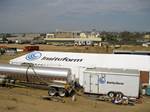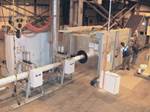Cured-in-place pipe: UV curing ensures liner performance in leaking pipe
When the Knoxville, Tenn. Utilities Board faced a needed repair of an actively leaking clay sewer pipe, it opted for Reline America's (Saltville, Va.) cured-in-place pipe cured with ultraviolet (UV) light.
The Utilities Board in Knoxville, Tenn., knew that cured-in-place pipe (CIPP) could enable faster, lower-cost repair of an 8-inch/203-mm diameter clay sewer pipe that had been in service in the city for more than 50 years. But pre-installation video showed active leaks in the pipe. Typically a CIPP liner is impregnated with resin that cures when it is exposed to heat, but active leaks create cool spots that could prevent thorough cure and result in reduced mechanical properties. City engineers were concerned: Would that prevent a successful CIPP liner installation?
They opted for an alternative, trademarked BLUE-TEK technology, from Reline America Inc. (Saltville, Va.), the exclusive North American partner for the technology established by Brandenburger GmbH (Landau, Pfalz, Germany). The fiberglass fabric liners were impregnated with an ultraviolet (UV)-curable Vipel unsaturated polyester from AOC Resins (Collierville, Tenn.), in which a photo-initiator additive would drive cure regardless of resin temperature. Moreover, the liner could be shipped without refrigeration.
Danielle Verderame, marketing coordinator for Reline America, says, “The project site was located in a combination residential and industrial area ... close to buildings. Open cutting and pipe bursting would have been expensive and disruptive options.”
The work was awarded to Portland Utilities Construction Co. LLC (PUCC, Portland, Tenn.), a company with years of experience in pipe bursting methods but none with CIPP repair. PUCC principal and manager Mike Woodcock says that Reline’s support helped turn the 2,991 ft/912m pilot project into a new capability for his company. “Reline America did an outstanding job in training our crew,” he says, which included giving them an understanding of the UV-curing process and the use of the wheeled “train” (see photo) that is used to expose the liner to UV light.
The liners were impregnated under controlled conditions in Reline’s ISO-certified facility, and Woodcock reports that the resin reacted smoothly during an installation so successful that the Utilities Board opted to reline 6,533 ft/1,991m of additional clay pipe.
Related Content
-
FACC Academy begins training, onboarding operations
FACC’s newly launched training platform will address skilled aerospace worker shortages head on, offering more than 250 specialized training courses for its entire workforce.
-
Belzona opens fifth European SuperWrap Training Centre
Global training facilities provide intensive, first-class installer and supervisor training for proper use and application of Belzona composite pipe and tank repair systems.
-
Toray, University of Chicago speed up polymer recycling R&D
A jointly developed multi-scale computational predictive technique can accurately predict viscoelasticity from the chemical structures of polymers, ramping up product maturation.















